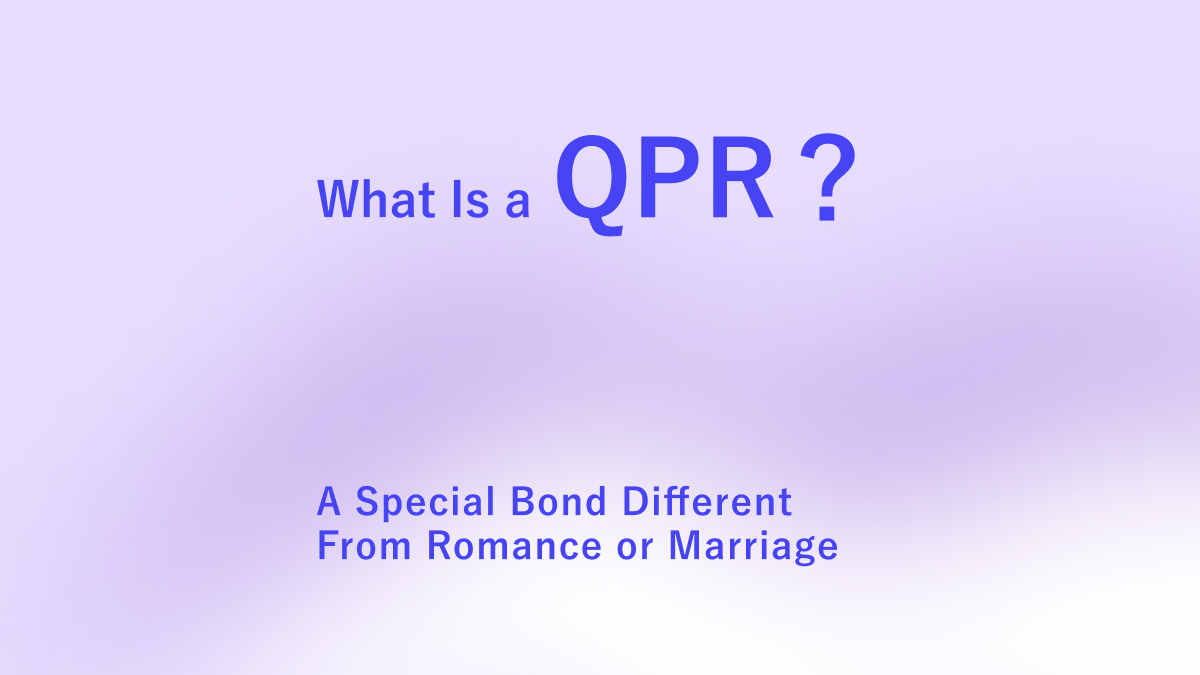What Is a Queerplatonic Relationship? A Special Bond Different From Romance or Marriage

In recent years, terms like “aromantic” and “asexual” have gradually become more familiar. However, the society we live in still strongly values romance and marriage. Many people might unconsciously think, “Falling in love, getting married, and building a family is the natural path in life.” Of course, it is true that many find happiness by following that path.
On the other hand, especially within aromantic and asexual communities, more people are beginning to express the desire for “a relationship that does not fit into romance or marriage but is built on a deep bond.” Seeking a form of intimacy that is different from romantic or sexual attraction—one such connection is called a “Queerplatonic Relationship” (QPR). In this article, we will introduce the concept of Queerplatonic Relationships.
What Are Aromantic and Asexual Identities?
To better understand Queerplatonic Relationships (QPRs), it is helpful to know what aromantic and asexual identities mean.
- Aromantic: People who do not experience romantic attraction or experience it very rarely.
- Asexual: People who do not experience sexual attraction or experience it very rarely.
Aromantic and asexual individuals may still desire special, close relationships. However, as mentioned earlier, we live in a society that often assumes romantic and sexual connections as the base of close relationships. This societal assumption can cause many aromantic and asexual individuals to feel anxious or troubled, thinking, “I might not be able to find a special partner.” But is romantic or sexual attraction truly necessary to build deep, meaningful relationships?
One form of intimate connection that differs from relationships based on romantic or sexual connection is called a “Queerplatonic Relationship” (QPR).
What Is a Queerplatonic Relationship?
A Queerplatonic Relationship (QPR) refers to a deeply bonded relationship that goes beyond the typical definition of friendship.
The term “Queerplatonic Relationship” was created within the asexual and aromantic communities in the 2010s.
The word “Queer” originally meant “strange” or “unusual” and was used as a derogatory term (a word meant to insult or show disrespect) toward the LGBTQ+ community. However, the LGBTQ+ community later reclaimed it, redefining it as a term for people whose sexuality or gender does not fit within existing societal frameworks. Today, it is used in a more positive sense.
The word “Platonic” comes from the name of the Greek philosopher Plato and is used to describe a deep emotional bond that does not involve sexual relationships*.
* While the term “platonic” typically implies a lack of sexual elements, some queerplatonic relationships may include sexual aspects. For more details, please see the section “Examples of Queerplatonic Relationships.”
By combining these words, the term “Queerplatonic” was created to describe relationships that do not fit into existing categories like romance or friendship. A QPR is not a typical romantic relationship, but it is considered a form of partnership based on strong mutual trust and support.
Examples of Queerplatonic Relationships
Queerplatonic Relationships can look very different depending on how the individuals are involved. Here are some examples:
Case 1: QPR Partners Living Together
A relationship where partners live together as life companions without romantic or sexual involvement. Some may choose to use legal marriage, while others live as roommates.
Case 2: QPR as Family (Non-Romantic, Non-Sexual)
Partners who consider each other “family” despite there being no blood relation. Some may formalize their bond through legal processes like adoption.
Case 3: QPR Including Sexual Involvement
A relationship where partners do not experience romantic feelings but engage in sexual relations. They form a partnership without romantic expectations, building intimacy in a way that feels comfortable for both.
Case 4: QPR for Co-Parenting (Non-Romantic, Non-Sexual or Non-Romantic, Sexual)
A relationship where partners raise children together without a romantic connection. Regardless of gender, they become co-parents as QPR partners and build a family together.
As these examples show, the structure of a queerplatonic relationship can vary greatly. Although the term itself emerged around 2010, many couples have been forming intimate relationships in diverse ways long before the term was created.
The Future of Queerplatonic Relationships
For a long time, society has considered romantic and family relationships as the “most important of human relationships.” Married couples are legally guaranteed various rights and are respected. In many cases, romantic relationships and dating are still seen as the stage before marriage. In a society that values romantic love above all else, not having romantic involvement can sometimes make someone be seen as “lonely” or “incomplete.”
On the other hand, there are also more voices heard from people who feel uncomfortable with, or suffocated by, the idea that only romantic relationships and marriage are important. While the concept of queerplatonic relationships has been spreading mainly within the aromantic and asexual communities, by introducing new terms like this, we can make visible the many types of relationships that go beyond just romantic ones.
Romantic love and marriage are not necessarily the ultimate goals in life. There are as many partnerships as there are couples. To create a society where everyone can build relationships and partnerships in a way that feels right for them, it is important to give these ideas some thought.
(Translation: Jennifer Martin)
